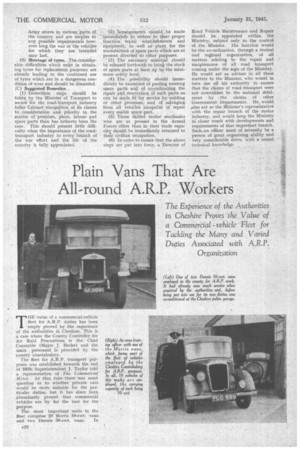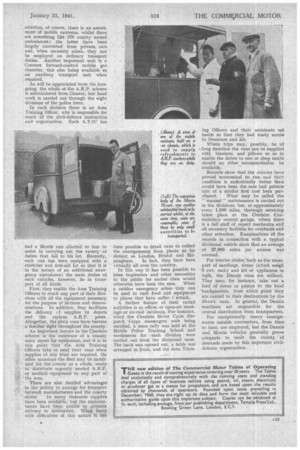Plain Vans That Are All-round A.R.P. Workers
Page 24

Page 25

If you've noticed an error in this article please click here to report it so we can fix it.
THE value of a commercial-vehicle fleet for A.R.P. duties has been amply proved by the experience of the authorities in Cheshire. This is a case where the County Controller for 'Air Raid Precautions, is the Chief Constable (Major J. Becke) and the
i main personnel s provided by the county constabulary.
The fleet for A.R.P. transport purposes Was established towards the end of 138, Superintendent J. Taylor told a representative of The Commercial Mo tor. At that time there was some question as to whether private cars
• would be more suitable for the particular duties, but it has since been abundantly proved that commercial vehicles are by far the best for the purpose. The most important units in the , fleet comprise 10 Morris 10-cwt. vans and two Dennis 30-cwt. vans. In addition, of course, there is an assortment of mobile canteens, whilst there are something like 170 county owned ambulances; the latter have been largely converted from private, cars and, when necessity arises, they can be employed on ordinary transport duties. Another important unit is a Cornmer forward-control mobile gas chamber, this also being available as an auxiliary transport unit when required.
As will be appreciated from the foregoing, the whole of the A.R.P. scheme is administered from Chester, but local work is carried out through the eight divisions of the police force.
In each division there is an Area Training Officer, who is responsible for much of the Civil-defence instruction and organization. EaCh A.T.0:' has had a Morris van allotted to him to assist in carrying out the variety of duties that fall to his lot. Recently, each van has been equipped with a stretcher and first-aid kit so that it is in the nature of an additional emergency ambulance; the main duties of such vehicles, however, lie in transport of all kinds.
First, they enable the Area Training Officers to reach any part of their divisions with all the equipment necessary . for the purpose of lectures and demonstrations. In addition, they facilitate
. the delivery rf supplies to depots and the various. A.R.P. posts. Altogether, the plain vans have become a familiar sight throughout the county.
An important feature in the Cheshire scheme is the existence of a county main stores for equipment, and it is to this point that the Area Training Officers take or send their vans when supplies of any -kind are required. On other occasions the fleet may be mobilbed for the County as a whole, ready distribute urgently needed A..R:P.
• or medical equipment to any part of the area.
• There are also . decided advantages in the abilityto arrange for transport betweefi manufaCturers and the county stores. In many instances supplies have been available,. but the manufacturers have been unable to promise delivery to destinatiOn. When faced with difficulties of this nature It 'has been possible to detail vans to collect the consignments from places as far distant as London, Bristol and Bir
mingham. In fact, they have been virtually all over the country.
In this way it has been possible to issue respirators and other necessities to the public far earlier than would otherwise have been the case. When a sudden emergency arises they can be used to rush food • and equipment to places that have sullen_ I attack.
A further feature of their varied activities is as offices at open-air meetings or air-raid incidents. For instance, when the Cheshire Motor Cycle Dispatch Corps messengers were being enrolled, a mass rally was held at the Mobile Police Training School and enrolments for each division were carried out from the divisional vans. The back was opened out, a table was arranged in front, and the Area Train
ing Officers and their assistants sat inside so that they had ready access to literature and kit.
Where trips may, possibly, be of long duration the vans can be supplied with blankets and pillows so as to enable the driver to rest or sleep inside should no other accommodation be available.
Records show that the ...7chieries have proved economical to run and their condition is undoubtedly better than would have been the case had private cars of a similar first cost been pur
chased. What may be called the " manual " maintenance is carried out in the divisions, but, at approximately every 1,500 miles, thorough servicing takes place at the Cheshire Constabulary central garage, where there is a full staff of expert mechanics and all necessary facilities for overhauls and other attention. Examinations of the records in connection with a typical divisional vehicle show that an average of 27,000 miles per annum was covered.
For heavier dutiesAuch as the transport of sandbags, sirens (which weigh 3 cwt. each) and kit or appliances in bulk, the Dennis vans are utilized. They may, for instance, take out a load of sirens or pumps to the local 'headquarters, from which point they are carried to their destinations by the 10-cwt.' vans. In general, the Dennis machines are responsible for the central distribution from headquarters.
For exceptionally heavy consignments outside contractors, from time to time, are employed, but the Dennis and Morris vehicles generally prove adequate to meet the variety. of demands made by this important civildefence organization.




















































